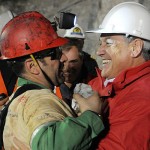A Miracle in Chile

A disquieting yet reassuring reality of our human species is that great calamities bring out the best in us.
A classic example of the moment is the Chilean mine disaster.
An apparent hopeless disaster when it first occurred, was turned by human ingenuity, courage, dedication and determination into a triumph that was shared by the world.
As the 33 miners, trapped a kilometer underground for over two months, were brought individually to the surface, the world literally wept with relief, pride, joy. We all suffered with the kinfolk, all felt the same emotion.
Isn’t it too bad that it takes unimaginable disaster to bring this quality out in humans? And it’s not only human disasters that provoke the sentiment.
Remember some years back when a couple of whales in the Arctic were trapped by the freeze up, and seemed destined to die until humans began the seemingly thankless task of making ice holes so the whales could breathe, leading them to open water?
Some thought it a waste of time, yet again the world empathized with the whales, and cheered the rescuers on.
It made little sense, since the Inuit would have made short work of the whales without outside interference, yet it was the right thing to do for fellow creatures in mortal peril.
We, in Canada, have had our share of trapped miners, albeit none so dramatic, long-lasting and initially hopeless as the Chilean one.
One need only recall disasters at the Springhill coal mine in Nova Scotia -- deepest in the world at some five kilometers. In 1891, 125 miners died in a coal dust fire, and then in 1956, around this time of year, a runaway mine train hit a power line. The resulting explosion and fire killed 39 and trapped others.
The Soviet invasion of Hungary and the Suez War, at the same time, overshadowed the disaster.
Then in 1958, some 13,000-feet deep, a “bump” (underground earthquake) trapped 174 miners, of whom 100 died. I was a young reporter for the Toronto Telegram at Springhill, and after, when all hope had been given up for more survivors, 12 were found.
Heroism among fellow miners was endemic. Without masks (to protect against methane gas) rescuers tunneled through 25 meters of earth and rubble to save the 12 six days later.
Then another six were found in a trapped pocket, three feet high, without food or water. Two days of digging rescued them – and a hero was born in Maurice Ruddick, whose singing and cheery optimism kept morale high. Ruddick, a black man, became Canada’s citizen of the year and a Canadian folk hero.
All of us on the Telegram team led by Bert Petlock and great journalists like Phyl Griffiths and Dorothy Howarth, were emotionally shaken by the fortitude and composure of the miners as they were rescued -- Mindful of the Chilean survivors. Those who work deep in mines, are a breed apart.
Prince Philip visited the site at the height of the rescue, and the world watched breathlessly. The town of Springhill was awarded the Carnegie Hero Medal for its rescue efforts. In 1959 the mine was closed forever.
Ironically, the 1956 and 1958 disasters occurred in late October, now forgotten everywhere but in Nova Scotia and in song – The Ballad of Springhill.
While the rescue at the Chilean mine has justifiably captured the world’s imagination, it was no greater a miracle of individual and collective courage of rescue and survival at Springhill, 52 years ago this October.